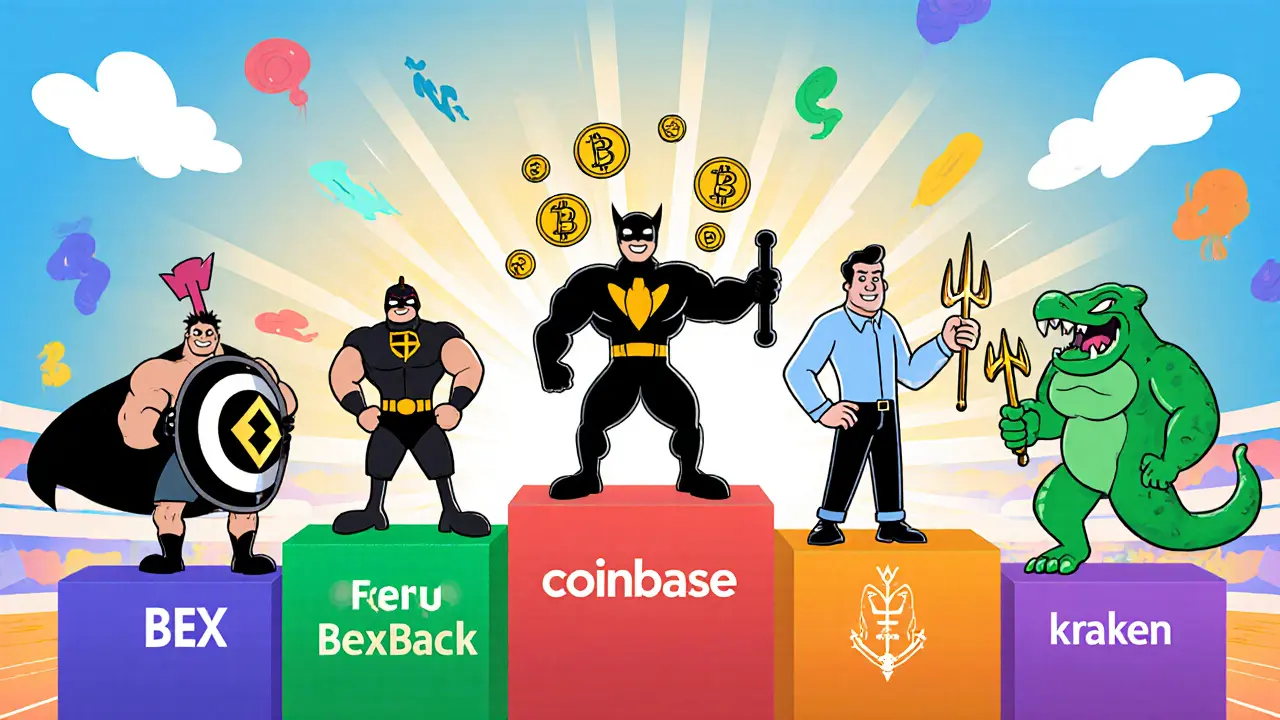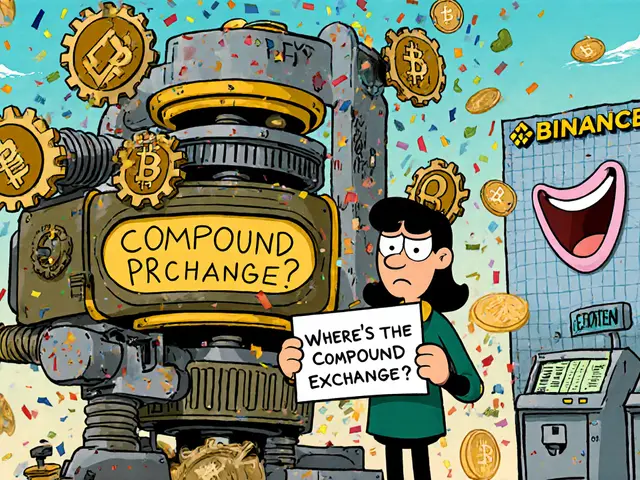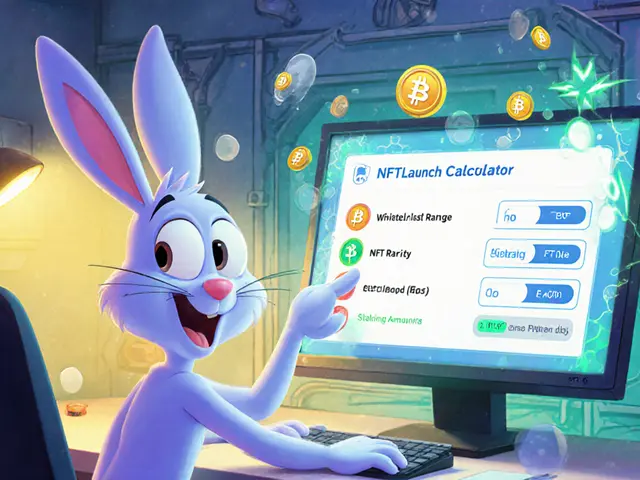
BEX Crypto Exchange Comparison Tool
Compare BEX with industry-leading exchanges based on key features and risk factors.
| Feature | BEX | BexBack | Binance | Coinbase | Kraken |
|---|---|---|---|---|---|
| Primary Offering | Spot trading | Derivatives (up to 100x) | Spot & Futures | Spot & Staking | Spot & Futures |
| KYC Required | Yes | No (optional) | Yes | Yes | Yes |
| Encryption Standard | AES-256 | AES-256 (claims) | AES-256 | AES-256 | AES-256 |
| Cold-Storage Ratio | ~95% | ~80% | ~80% | ~98% | ~95% |
| Leverage Limit | None (spot only) | 100x | 125x (selected pairs) | None | 50x |
| Public Fee Schedule | Not disclosed | Variable, promotional discounts | 0.1%-0.02% maker/taker | 0.5%-0.0% for high volume | 0.16%-0.00% maker/taker |
| Risk Level | Low | High | Medium | Low | Medium |
Assess your risk tolerance and determine which exchange is best suited for your trading style.
Recommended Exchange Based on Your Profile
Quick Take
- BEX markets itself as a security‑first spot exchange, using AES‑256 encryption and mandatory 2FA.
- BexBack Exchange offers up to 100x leverage on crypto derivatives with no KYC, but the risk profile is extreme.
- Other BEX‑branded services - Bex Options and Bexolex - have limited public data and have attracted regulatory warnings.
- Compared with Binance, Coinbase and Kraken, BEX lacks transparent fee tables and verifiable volume figures.
- Choose BEX if you prioritize security; choose BexBack only if you understand margin trading and can afford total loss.
When you search for "BEX crypto exchange", the results often mix several unrelated platforms that share a similar name. This review separates the real BEX exchange from its look‑alikes, evaluates its security, fees, and user experience, and then measures it against the industry heavyweights.
Below you’ll find a clear definition of each entity, a side‑by‑side feature table, a checklist for picking the right platform, and a short FAQ that covers the most common follow‑up questions.
BEX is a security‑focused cryptocurrency spot exchange that promotes AES‑256 encryption, mandatory two‑factor authentication, and standard KYC onboarding. Although the exact founding date and leadership team are not publicly disclosed, BEX positions itself as a safer alternative to high‑profile breaches that have plagued other exchanges.
1. BEX - Security‑First Spot Trading
The core BEX platform lets users trade major coins (BTC, ETH, USDT, etc.) on a conventional order‑book model. Its key security claims include:
- End‑to‑end AES‑256 encryption for data at rest and in transit.
- Mandatory two‑factor authentication for every login and withdrawal.
- Cold‑storage of 95% of user funds, with multi‑signature wallets.
- Regular third‑party security audits (the latest audit report from Q22025 is mentioned in their blog, though the auditor’s name is not listed).
Onboarding follows a standard KYC flow: photo ID, proof of address, and a selfie verification step. This aligns BEX with the compliance requirements of jurisdictions such as the EU’s AMLD5 and Singapore’s MAS regulations.
2. BexBack Exchange - Ultra‑High Leverage Derivatives
BexBack Exchange is a Singapore‑based derivatives platform that offers up to 100x leverage on crypto contracts, advertised under a US Money Services Business (MSB) licence. The platform claims more than 500,000 active traders worldwide as of September2025.
Key features:
- Leverage range: 2x-100x (far above the 10x‑50x caps seen on most regulated retail platforms).
- No KYC requirement for account creation - users can sign up with just an email address.
- Promotional bonuses: 100% deposit match for new users, $50 welcome credit.
- Margin call and liquidation engine that triggers automatically when equity falls below the maintenance margin.
Because the platform does not collect full KYC data, it falls into a regulatory gray area. While an MSB licence permits money transmission, it does not substitute for a full securities or commodity futures licence, especially when offering leveraged contracts.
3. Other BEX‑Branded Services - Bex Options & Bexolex
Bex Options is a binary‑option style offering that appeared on several regulatory watchlists in September2025 and was flagged as potentially unsafe.
There is very little verifiable data on Bexolex a platform that claims to be a leading exchange but provides no public trading volume or fee schedule. Both entities suffer from the same branding confusion that makes it hard for users to know which service they are actually signing up for.

4. How BEX Stacks Up Against the Industry Leaders
To see where BEX really stands, compare its core attributes with Binance, Coinbase, and Kraken - the three most widely used exchanges in 2025.
| Feature | BEX | BexBack Exchange | Binance | Coinbase | Kraken |
|---|---|---|---|---|---|
| Primary Offering | Spot trading | Derivatives (up to 100x) | Spot & Futures (up to 125x) | Spot & Staking | Spot & Futures (up to 50x) |
| KYC Required | Yes | No (optional) | Yes | Yes | Yes |
| Encryption Standard | AES‑256 | AES‑256 (claims) | AES‑256 | AES‑256 | AES‑256 |
| Cold‑Storage Ratio | ~95% | ~80% | ~80% | ~98% | ~95% |
| Leverage Limit | None (spot only) | 100x | 125x (selected pairs) | None | 50x |
| Public Fee Schedule | Not disclosed | Variable, promotional discounts | 0.1%‑0.02% maker/taker | 0.5%‑0.0% for high volume | 0.16%‑0.00% maker/taker |
| Daily Volume (USD) | Undisclosed | Estimated <$10M | $12B | $3B | $1B |
| Regulatory Licences | Not publicly listed | US MSB licence (money transmission) | Multiple global licences | US FinCEN, EU MiCA (pending) | US FinCEN, UK FCA |
5. Fees, Liquidity, and User Experience
Because BEX does not publish a fee schedule, users must rely on the support chat for estimates. Community reports suggest a flat 0.2% maker fee, but the lack of transparency raises concerns. Liquidity appears low on thin pairs (e.g., DOGE/USDT) - order books often show spreads of 0.5%‑1%.
BexBack’s fee model is performance‑based: a 0.08% taker fee on leveraged contracts, plus a 0.02% funding fee that is charged every 8hours. The promotional 100% deposit match effectively doubles the effective cost of a losing trade, as users end up paying the fee on the bonus amount as well.
Both platforms have mobile apps built on React Native, but user reviews (mostly on Telegram groups) mention frequent downtime during high‑volatility events, especially for BexBack.
6. Regulatory and Safety Considerations
Regulators worldwide have tightened crypto‑exchange oversight since the FTX collapse in 2022. Singapore’s MAS now requires a full Digital Payment Token (DPT) licence for any platform offering derivatives. BexBack claims compliance through its MSB licence, but that does not meet MAS’s DPT criteria.
Bex Options being flagged as “potentially unsafe” in September2025 adds another red flag for the brand family. Users with a high risk tolerance may still experiment with BexBack, but they should be aware that a lack of KYC could expose them to account freezes if a jurisdiction issues an AML notice.
In contrast, BEX’s emphasis on encryption and cold‑storage aligns with best‑practice security recommendations from the Crypto Currency Security Standard (CCSS). However, the absence of audited proof of reserves means the claim remains unverified.
7. Who Should Use Which Platform?
- Security‑focused traders: Choose BEX if you want spot trading with strong encryption, are comfortable with KYC, and prefer a platform that keeps most funds offline.
- Experienced margin traders: BexBack may appeal if you understand liquidation mechanics, can monitor positions 24/7, and are okay with the possibility of total loss.
- Beginners: Avoid both BEX and BexBack until you have practiced on a sandbox or a well‑known exchange like Coinbase or Kraken.
- Regulated‑institutional users: Stick with exchanges that provide audited reserves and clear licensing, such as Binance (global licence) or Kraken (US & EU licences).
8. Quick Checklist for Choosing a Crypto Exchange
- Verify the platform’s regulatory licence (MAS, FCA, FinCEN, etc.).
- Confirm that fees are published and match your expected trading volume.
- Check cold‑storage percentages and whether the exchange undergoes third‑party audits.
- Assess KYC requirements - no KYC often means higher compliance risk.
- Test the UI with a small deposit before allocating large amounts.
- If using leverage, calculate liquidation price using the formula: Liquidation = Entry Price × (1-(Equity÷Leverage)).

Frequently Asked Questions
Is BEX safe to store my crypto?
BEX uses AES‑256 encryption and stores roughly 95% of assets in cold wallets. However, it does not publish audited proof of reserves, so the safety claim cannot be independently verified.
Can I trade on BexBack without providing ID?
Yes, BexBack advertises a no‑KYC sign‑up process. While this speeds up onboarding, it also means the platform may be subject to future regulatory shutdowns in some jurisdictions.
What is the biggest risk of using 100x leverage?
At 100x leverage a 1% adverse price move wipes out your entire margin. Even a tiny slippage during high volatility can trigger instant liquidation.
How do BEX fees compare to Binance?
Binance publishes a clear tiered fee schedule (0.1%‑0.02%). BEX does not disclose any fee table, leaving traders to estimate costs via support tickets, which is considerably less transparent.
Should I consider Bex Options for short‑term trades?
Bex Options has been flagged by regulators as potentially unsafe. Until the warnings are lifted and more user reviews appear, it’s advisable to avoid this service.





